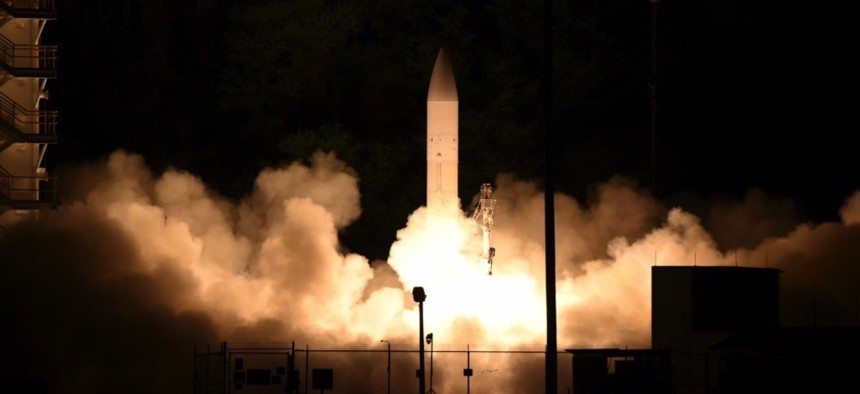
A test launch of the Army-Navy common hypersonic glide body (C-HGB) in March 2020. DOD
US Army’s Plan Needlessly Duplicates Air Force Strike Capabilities
The service would do better to follow the Marines’ path toward specialization.
One year after Marine Corps Commandant Gen. David Berger published his service’s force design plan, Army Chief of Staff Gen. James McConville has released a white paper explaining how the Army will transform into a force capable of multi-domain warfare. Both documents lay out how the two services intend to compete, deter, and win against peer adversaries, but their approaches differ in key respects. While the Marine Corps is divesting its duplicative capabilities for land warfare, the Army is investing in long-range strike capabilities that duplicate what the Air Force can already do.
According to General Berger, the Marine Corps is transforming from a “second land army” to an expeditionary force capable of conducting sea denial and other missions from littoral areas covered by Chinese anti-access/area-denial, or A2/AD, threats. To fund this transformation, the Marine Corps is divesting tanks, cannon artillery, bridging equipment, and other capabilities that will continue to reside in the Army, which General Berger has said he would rely on should Marines have a need for them.
Reducing excessive overlap across the services in this manner is exactly what is needed if DoD is to transform for great power competition and conflict with tightening budgets. However, it appears the Army is taking the opposite approach, at least for its strike forces. According to General McConville, the Army will invest billions to develop new surface-to-surface weapons and its own ISR, communication networks, and other systems needed to locate and attack targets over long ranges. This will allow the Army to attack the same targets that Air Force bombers and fighters can strike today, including Chinese A2/AD threats. In other words, the Army wants new long-range strike capabilities that would make them, in a sense, a second Air Force even as it claims it is doing so in the name of “jointness.”
In truth, the Army’s long-range strike plans are the antithesis of jointness. Real jointness is about using the right capabilities regardless of service origin at the right places and right times to achieve a commander’s objectives. Of course, it is appropriate to challenge traditional mission responsibilities if a service has a better idea. In the case of long-range strike, the Army does not offer a better, more cost-effective solution for the Indo-Pacific. The facts speak for themselves.
Unlike Army missile batteries, which must be postured in countries that allow access to U.S. land forces, stealth bombers have the range, low observability, and other features needed to attack targets with shorter-range, smaller-sized, and substantially lower-cost weapons. A single B-2 stealth bomber can penetrate contested areas and deliver 80 short-range 500-pound guided bombs that cost $25,000 each. In comparison, a surface-launched ballistic missile with similar range could cost $5 million to $10 million or more—and double that for longer ranges and a requirement to carry a hypersonic glide vehicle.
Three rules of thumb capture this relationship between weapons range, size, and cost. First, the farther a weapon must fly, the larger it must be; it needs to carry more fuel for its engine, sophisticated guidance systems to direct its flight, and so on. Second, surface-launched missiles are generally larger and more expensive than air-launched weapons with similar ranges and payloads, since the former must have rockets that boost them from ground level to trajectories that allow them to reach distant targets. Third, the faster a weapon flies the more costly it is—an important consideration for hypersonic weapons.
Weapon costs are a critical consideration when the requirement is to attack tens of thousands of targets during a clash with a peer adversary. It is also important to consider the effectiveness of different weapons against challenging targets such as road-mobile missile launchers. A rule of thumb in this case is long-range weapons that require tens of minutes to reach their aimpoints after launch are less effective against highly mobile targets. For example, a ballistic missile launched from Japan could require 10 to 15 minutes to reach a mobile HQ-9 surface-to-air missile system defending China’s coastline. (This kind of thing is a potential mission for Army long-range fires, Gen. McConville has said.) Passing target data to an Army fire control center, assessing it, deconflicting airspace, and then commanding a launch would add more minutes. Combined, the time needed to place a ballistic missile warhead on the HQ-9 could exceed the five minutes a HQ-9 needs to “scoot” after it shoots. In contrast, penetrating bombers and fighters can find, track, and kill mobile targets before they move or take other defensive actions.
The Army’s long-range strike plan is one example of the need to integrate the services’ future force visions. A good beginning would be to assess on a cost-per-effect basis how DoD as a whole should maximize its long-range strike capacity. A focused review of the services’ roles and missions would be a complementary initiative. It is clear the Marine Corps is willing to trust other services to perform their core missions in a fight with China. As for the Army, its long-range strike ambitions suggest it may be concerned with another pacing challenge—ensuring it does not lose budget share due to the limited relevance of land-based maneuver warfare in the Indo-Pacific. DoD will waste its precious resources on excessively redundant capabilities if it does nothing to address this kind of behavior. The Marine Corps is now leading the way. If the other services fail to follow suit, America’s military will be weaker for it.
Mark Gunzinger is Director, Future Concepts and Capability Assessments, at the Mitchell Institute for Aerospace Studies.
NEXT STORY: What Is DevSecOps, Anyway?



